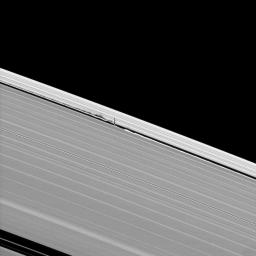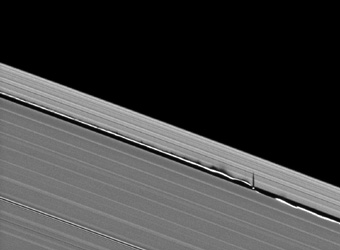
|
Rippling Shadows
- Click the image above for a larger view
- Full-Res JPEG (1014 x 1014) (104.9 kB)
- Full-Res TIFF (1014 x 1014) (1.0 MB)
Caption:
Vertical structures created by Saturn's small moon Daphnis cast long shadows across the rings in this dramatic image taken as the planet approaches its mid-August 2009 equinox.
Daphnis,8 kilometers(5 miles)across, occupies an inclined orbit within the 42-kilometer (26-mile) wide Keeler Gap in Saturn's outer A ring. Recent analyses by imaging scientists published in the Astronomical Journal illustrate how the moon's gravitational pull perturbs the orbits of the particles forming the gap's edge and sculpts the edge into waves that have both horizontal and vertical components.
Measurements of the shadows in this and other images indicate that the vertical structures range between one-half to 1.5 kilometers tall (about one-third to one mile), making them as much as 150 times as high as the ring is thick. The main A, B and C rings are only about 10 meters (about 30 feet) thick. Daphnis itself can be seen casting a shadow onto the nearby ring.
In figure 1, a second version of the image that has been magnified to twice its original size and cropped is also shown.
This image of shadows on the rings and others like it (see PIA11656 and PIA11655 ) are only possible around the time of Saturn's equinox which occurs every half-Saturn-year (equivalent to about 15 Earth years). The illumination geometry that accompanies equinox lowers the sun's angle to the ringplane and causes out-of-plane structures to cast long shadows across the rings.
This view looks toward the sunlit side of the rings from about 48 degrees above the ringplane. The image was taken in visible light with the Cassini spacecraft narrow-angle camera on June 8, 2009. The view was acquired at a distance of approximately 666,000 kilometers (414,000 miles) from Daphnis and at a Sun-Daphnis-spacecraft, or phase, angle of 130 degrees. Image scale is 4 kilometers (about 2 miles) per pixel.
Background Info:
The Cassini-Huygens mission is a cooperative project of NASA, the European Space Agency and the Italian Space Agency. The Jet Propulsion Laboratory, a division of the California Institute of Technology in Pasadena, manages the mission for NASA's Science Mission Directorate, Washington, D.C. The Cassini orbiter and its two onboard cameras were designed, developed and assembled at JPL. The imaging operations center is based at the Space Science Institute in Boulder, Colo.
For more information about the Cassini-Huygens mission visit http://saturn.jpl.nasa.gov/ . The Cassini imaging team homepage is at http://ciclops.org .
Cataloging Keywords:
| Name | Value | Additional Values |
|---|---|---|
| Target | Daphnis | A Ring, B Ring, C Ring, Saturn, Saturn Rings |
| System | Saturn | |
| Target Type | Satellite | Planet, Ring |
| Mission | Cassini-Huygens | |
| Instrument Host | Cassini Orbiter | |
| Host Type | Orbiter | |
| Instrument | Imaging Science Subsystem (ISS) | |
| Detector | Narrow Angle Camera | |
| Extra Keywords | Gap, Grayscale, Shadow, Visual, Wave | |
| Acquisition Date | ||
| Release Date | 2009-06-11 | |
| Date in Caption | 2009-06-08 | |
| Image Credit | NASA/JPL/Space Science Institute | |
| Source | photojournal.jpl.nasa.gov/catalog/PIA11654 | |
| Identifier | PIA11654 | |

